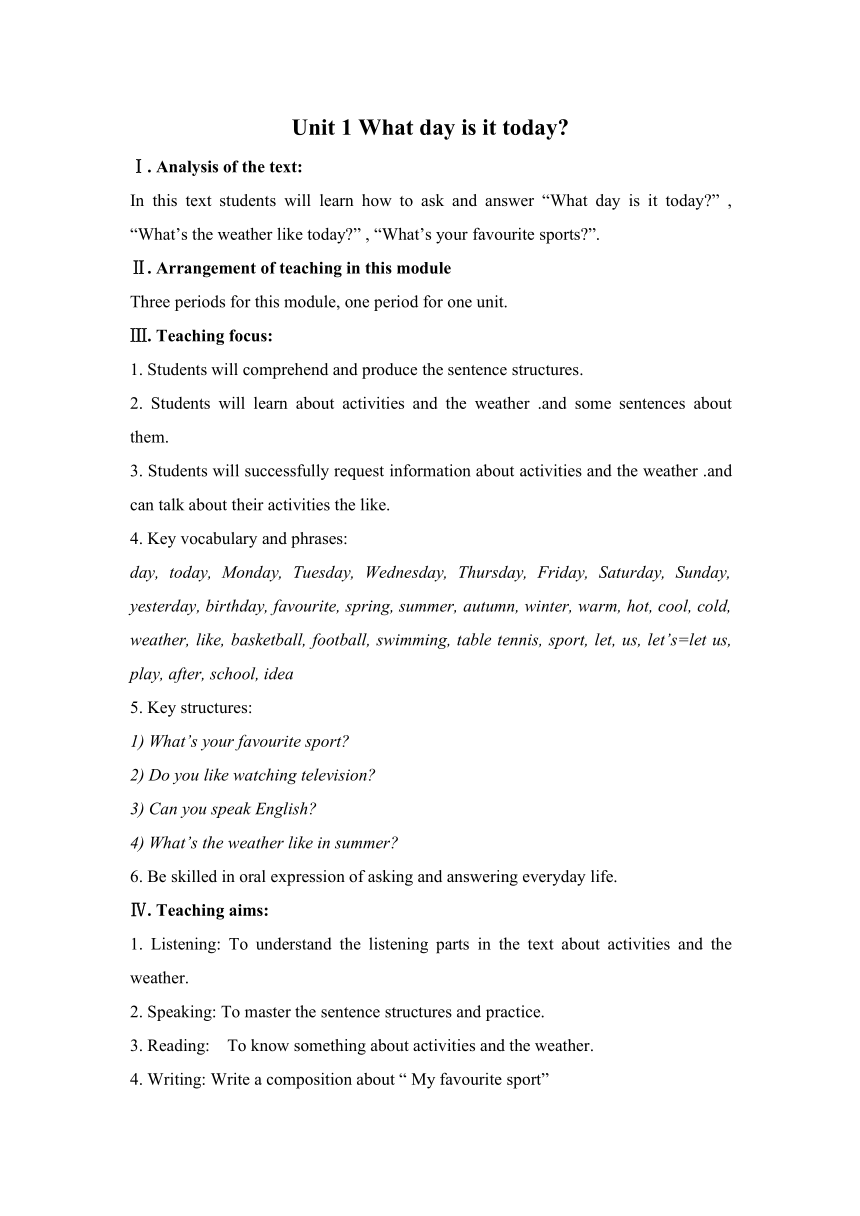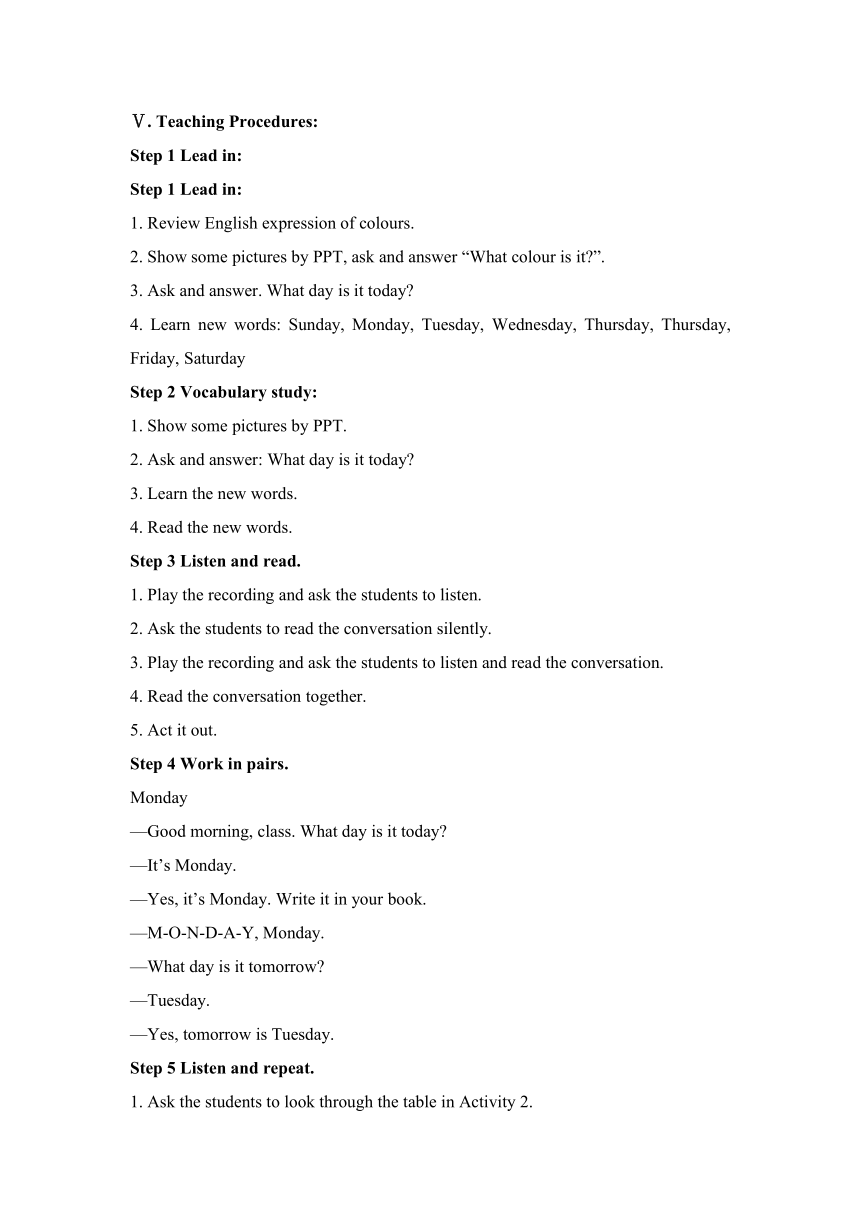Unit 1 What day is it today
文档属性
| 名称 | Unit 1 What day is it today |

|
|
| 格式 | zip | ||
| 文件大小 | 55.2KB | ||
| 资源类型 | 教案 | ||
| 版本资源 | 外研版 | ||
| 科目 | 英语 | ||
| 更新时间 | 2012-12-18 19:51:53 | ||
图片预览


文档简介
Unit 1 What day is it today?
Ⅰ. Analysis of the text:
In this text students will learn how to ask and answer “What day is it today?” , “What’s the weather like today?” , “What’s your favourite sports?”.
Ⅱ. Arrangement of teaching in this module
Three periods for this module, one period for one unit.
Ⅲ. Teaching focus:
1. Students will comprehend and produce the sentence structures.
2. Students will learn about activities and the weather .and some sentences about them.
3. Students will successfully request information about activities and the weather .and can talk about their activities the like.
4. Key vocabulary and phrases:
day, today, Monday, Tuesday, Wednesday, Thursday, Friday, Saturday, Sunday, yesterday, birthday, favourite, spring, summer, autumn, winter, warm, hot, cool, cold, weather, like, basketball, football, swimming, table tennis, sport, let, us, let’s=let us, play, after, school, idea
5. Key structures:
1) What’s your favourite sport?
2) Do you like watching television?
3) Can you speak English?
4) What’s the weather like in summer?
6. Be skilled in oral expression of asking and answering everyday life.
Ⅳ. Teaching aims:
1. Listening: To understand the listening parts in the text about activities and the weather.
2. Speaking: To master the sentence structures and practice.
3. Reading: To know something about activities and the weather.
4. Writing: Write a composition about “ My favourite sport”
Ⅴ. Teaching Procedures:
Step 1 Lead in:
Step 1 Lead in:
1. Review English expression of colours.
2. Show some pictures by PPT, ask and answer “What colour is it?”.
3. Ask and answer. What day is it today?
4. Learn new words: Sunday, Monday, Tuesday, Wednesday, Thursday, Thursday, Friday, Saturday
Step 2 Vocabulary study:
1. Show some pictures by PPT.
2. Ask and answer: What day is it today?
3. Learn the new words.
4. Read the new words.
Step 3 Listen and read.
1. Play the recording and ask the students to listen.
2. Ask the students to read the conversation silently.
3. Play the recording and ask the students to listen and read the conversation.
4. Read the conversation together.
5. Act it out.
Step 4 Work in pairs.
Monday
—Good morning, class. What day is it today?
—It’s Monday.
—Yes, it’s Monday. Write it in your book.
—M-O-N-D-A-Y, Monday.
—What day is it tomorrow?
—Tuesday.
—Yes, tomorrow is Tuesday.
Step 5 Listen and repeat.
1. Ask the students to look through the table in Activity 2.
2. Play the recording and ask the students to listen.
3. Listen and repeat.
4. Now point, ask and answer.
What day is it? It’s …
5. Work in pairs.
Step 6 Read and match.
1. Ask the students to look through the sentences in Activity 3.
2. Match the sentences.
1 Today is Wednesday. What day is it tomorrow? a) Sunday.
2 Today is Friday. What day is it tomorrow? b) Tuesday.
3 Today is Monday. What day is it tomorrow? c) Thursday.
4 Today is Saturday. What day is it tomorrow? d) Saturday.
5. Call back the answer from the whole class and check the answer.
Keys: 1. c 2. d 3. b 4. a
Step 7 Work in pairs.
1. Ask and answer like this.
—Today is … What day is it tomorrow?
—It’s …
Step 8 Listen and write.
1. Play the recording of Activity 5.
2. Listen and write.
1. ________________ 5 .________________
2. ________________ 6. ________________
3 .________________ 7. ________________
4. ________________
3. Call back the answer from the whole class and check the answer.
Step 9 Write.
1. Ask the students to read the words in Activity 6.
2. Complete the table in Activity 6.
1 What ____________ is it today?
2 Today is Tuesday. Tomorrow is ___________.
3 Thursday, Friday, ____________
4 ___________, Monday, Tuesday.
5 It’s Wednesday today. Tomorrow is ________
3. Call back the answer from the whole class and check the answer.
Keys: 1. day 2. Wednesday 3. Saturday 4. Sunday 5. Thursday
Step 10 Work in pairs.
1. Ask and answer like this.
A: What day is it today?
B: It’s …
A: What day is it tomorrow?
B: It’s …
A: My favourite day is… What day is your favourite day?
B: It’s …
2. Work in pairs.
Ⅰ. Analysis of the text:
In this text students will learn how to ask and answer “What day is it today?” , “What’s the weather like today?” , “What’s your favourite sports?”.
Ⅱ. Arrangement of teaching in this module
Three periods for this module, one period for one unit.
Ⅲ. Teaching focus:
1. Students will comprehend and produce the sentence structures.
2. Students will learn about activities and the weather .and some sentences about them.
3. Students will successfully request information about activities and the weather .and can talk about their activities the like.
4. Key vocabulary and phrases:
day, today, Monday, Tuesday, Wednesday, Thursday, Friday, Saturday, Sunday, yesterday, birthday, favourite, spring, summer, autumn, winter, warm, hot, cool, cold, weather, like, basketball, football, swimming, table tennis, sport, let, us, let’s=let us, play, after, school, idea
5. Key structures:
1) What’s your favourite sport?
2) Do you like watching television?
3) Can you speak English?
4) What’s the weather like in summer?
6. Be skilled in oral expression of asking and answering everyday life.
Ⅳ. Teaching aims:
1. Listening: To understand the listening parts in the text about activities and the weather.
2. Speaking: To master the sentence structures and practice.
3. Reading: To know something about activities and the weather.
4. Writing: Write a composition about “ My favourite sport”
Ⅴ. Teaching Procedures:
Step 1 Lead in:
Step 1 Lead in:
1. Review English expression of colours.
2. Show some pictures by PPT, ask and answer “What colour is it?”.
3. Ask and answer. What day is it today?
4. Learn new words: Sunday, Monday, Tuesday, Wednesday, Thursday, Thursday, Friday, Saturday
Step 2 Vocabulary study:
1. Show some pictures by PPT.
2. Ask and answer: What day is it today?
3. Learn the new words.
4. Read the new words.
Step 3 Listen and read.
1. Play the recording and ask the students to listen.
2. Ask the students to read the conversation silently.
3. Play the recording and ask the students to listen and read the conversation.
4. Read the conversation together.
5. Act it out.
Step 4 Work in pairs.
Monday
—Good morning, class. What day is it today?
—It’s Monday.
—Yes, it’s Monday. Write it in your book.
—M-O-N-D-A-Y, Monday.
—What day is it tomorrow?
—Tuesday.
—Yes, tomorrow is Tuesday.
Step 5 Listen and repeat.
1. Ask the students to look through the table in Activity 2.
2. Play the recording and ask the students to listen.
3. Listen and repeat.
4. Now point, ask and answer.
What day is it? It’s …
5. Work in pairs.
Step 6 Read and match.
1. Ask the students to look through the sentences in Activity 3.
2. Match the sentences.
1 Today is Wednesday. What day is it tomorrow? a) Sunday.
2 Today is Friday. What day is it tomorrow? b) Tuesday.
3 Today is Monday. What day is it tomorrow? c) Thursday.
4 Today is Saturday. What day is it tomorrow? d) Saturday.
5. Call back the answer from the whole class and check the answer.
Keys: 1. c 2. d 3. b 4. a
Step 7 Work in pairs.
1. Ask and answer like this.
—Today is … What day is it tomorrow?
—It’s …
Step 8 Listen and write.
1. Play the recording of Activity 5.
2. Listen and write.
1. ________________ 5 .________________
2. ________________ 6. ________________
3 .________________ 7. ________________
4. ________________
3. Call back the answer from the whole class and check the answer.
Step 9 Write.
1. Ask the students to read the words in Activity 6.
2. Complete the table in Activity 6.
1 What ____________ is it today?
2 Today is Tuesday. Tomorrow is ___________.
3 Thursday, Friday, ____________
4 ___________, Monday, Tuesday.
5 It’s Wednesday today. Tomorrow is ________
3. Call back the answer from the whole class and check the answer.
Keys: 1. day 2. Wednesday 3. Saturday 4. Sunday 5. Thursday
Step 10 Work in pairs.
1. Ask and answer like this.
A: What day is it today?
B: It’s …
A: What day is it tomorrow?
B: It’s …
A: My favourite day is… What day is your favourite day?
B: It’s …
2. Work in pairs.
同课章节目录
- Starte
- Module 1 My teacher and my friends
- Module 2 My English lesson
- Module 3 My English book
- Module 4 My everyday life
- Module 1 My classmates
- Unit 1 Nice to meet you.
- Unit 2 I'm Wang Lingling and I'm thirteen years ol
- Unit 3 Language in use.
- Module 2 My family
- Unit 1 Is this your mum?
- Unit 2 These are my parents.
- Unit 3 Language in use.
- Module 3 My school
- Unit 1 There are thirty students in my class.
- Unit 2 The library is on the left of the playgroun
- Unit 3 Language in use.
- Module 4 Healthy food
- Unit 1 We've got lots of apples.
- Unit 2 Is your food and drink healthy?
- Unit 3 Language in use.
- Module 5 My school day
- Unit 1 I love history.
- Unit 2 We start work at nine o'clock.
- Unit 3 Language in use.
- Revision module A
- Module 6 A trip to the zoo
- Unit 1 Does it eat meat?
- Unit 2 The tiger lives in Asia.
- Unit 3 Language in use.
- Module 7 Computers
- Unit 1 How do I write my homework on the computer?
- Unit 2 When do you use a computer?
- Unit 3 Language in use.
- Module 8 Choosing presents
- Unit 1 I always like birthday parties.
- Unit 2 She often goes to concerts.
- Unit 3 Language in use.
- Module 9 People and places
- Unit 1 We're enjoying the school trip a lot.
- Unit 2 They're waiting for buses or trains.
- Unit 3 Language in use.
- Module 10 Spring Festival
- Unit 1 Are you getting ready for Spring Festival?
- Unit 2 My mother's cleaning our houses and sweepin
- Unit 3 Language in use.
- Revision module B
